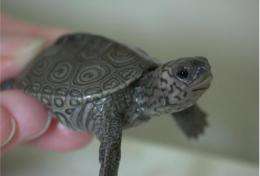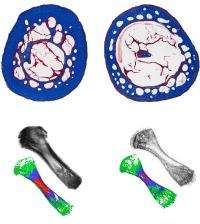Reduced bone density, stunted growth in turtles exposed to common chemical

Manufactured until 1977, and banned by the Environmental Protection Agency in 1979, pentachlorobiphenyls (PCBs) are chemicals still commonly found in the environment because they break down slowly. Now, a husband and wife research team at the University of Missouri and Westminster College in Fulton, Mo., have found that exposure to one of the chemicals has effects on growth and bone density in turtles. This knowledge could lead to insights on PCBs effects on humans and the environment.
"Turtles also are known as an 'indicator species' because they are often used as a gauge for the health of an entire ecosystem," said Dawn Holliday, co-researcher and assistant professor of biology at Westminster College in Fulton, Mo. "By finding the effects of PCBs on turtles, we can understand possible effects the chemicals might have on humans."
Researchers studied PCB 126, a version of the chemical compound once used in pesticides and electric transformers. PCBs are absorbed by eating exposed animals or drinking exposed water and are stored in fat cells. PCBs can affect the endocrine system and, thus, the regulation of hormones that control growth and other body functions.
Scientists know that people harbor PCBs in many tissues; however, little is known about the effect the chemicals have on people. Dawn Holliday said previous research on people accidentally exposed to the chemical through spills or accidents has shown correlations between exposure and stunted growth in humans.

"By studying the effect of PCB exposure on turtles, we can better understand how PCB exposure impacts people," said Casey Holliday, co-researcher and assistant professor of anatomy in the MU School of Medicine. "People are high on the food chain, and thus more susceptible to accumulation of PCBs. Smaller animals ingest PCBs. As large animals eat these smaller animals, the chemical stays in the food chain, as it is deposited in fat cells and doesn't leave the body. Even people not directly exposed to extreme amounts of PCB may see effects; this research will help us understand these effects better."
In the study, the researchers examined Diamondback terrapins (Malaclemys terrapin) that were exposed to an amount of PCB 126 that was equivalent to the exposure the reptiles would experience in an urban aquatic environment, such as the mid-Atlantic's Chesapeake Bay or Louisiana's wetlands. The turtles were exposed to the chemical for six months, and were compared to a group of unexposed turtles kept in the same laboratory. Exposed turtles were smaller, had more juvenile features, and lower bone density. In a previous study, Dawn Holliday found that PCB-exposed turtles had a lower metabolic rate.
The changes have an effect on the way the turtles function. When diving for long periods of time, turtles stored calcium in their shells to help maintain a normal physiological state while they hold their breath. Lower bone density means less calcium, possibly resulting in a reduced ability to stay underwater for very long. Additionally, turtles with low bone density may produce eggs with thinner shells, leaving them more susceptible to predators. Lower density may result in a softer shell, enabling more predators to eat turtles. Affected turtles may also have difficulty eating hard prey, such as crabs, because the reptiles have smaller, weaker jaws and cannot easily crack shells.
The study was published in Aquatic Toxicology.
Provided by University of Missouri-Columbia















